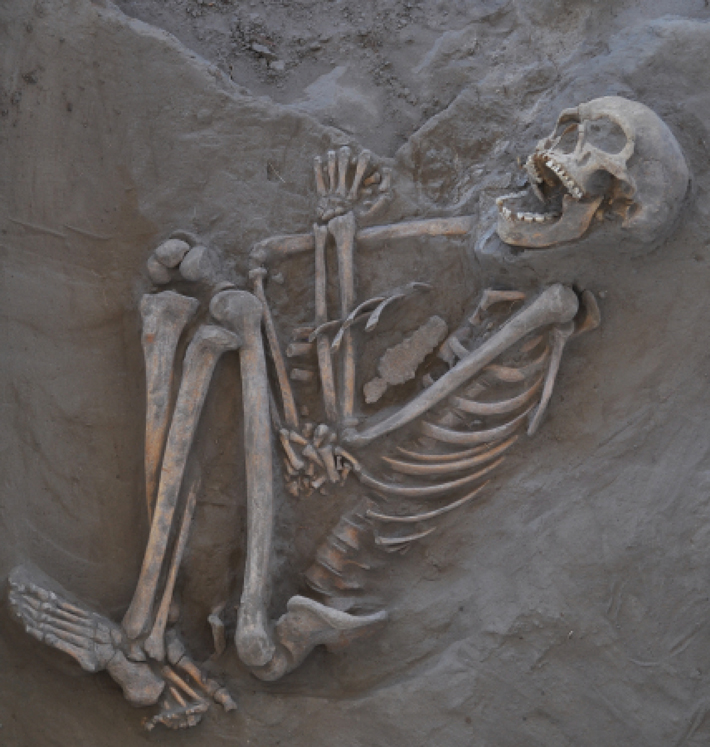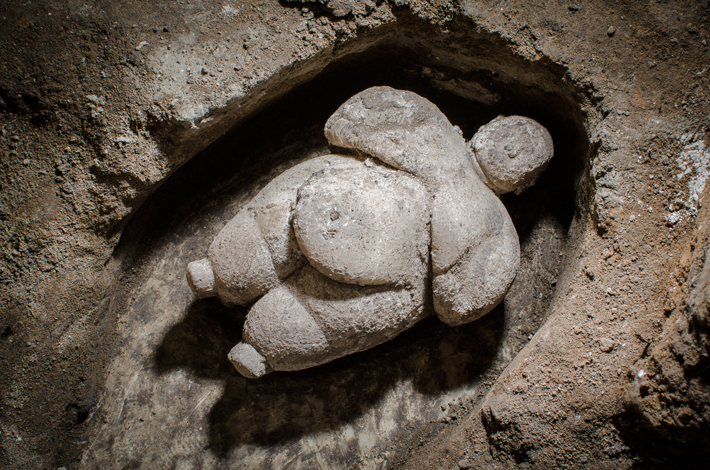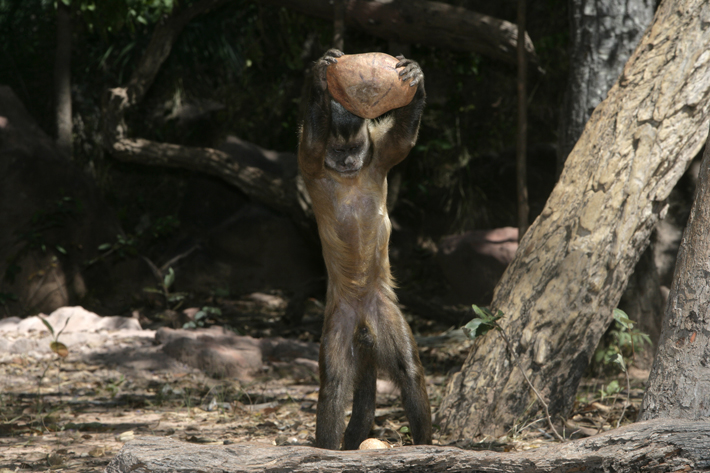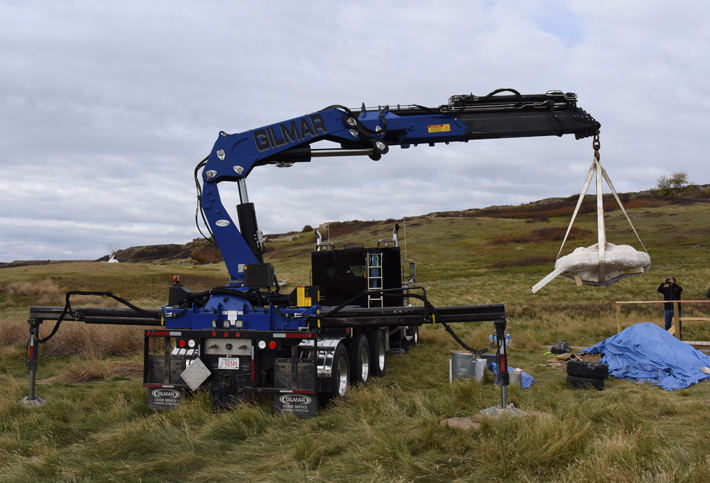From the Trenches
Death by Boomerang
By ERIC A. POWELL
Monday, December 12, 2016
 While on survey in a national park in southern Australia, archaeologists recently discovered a male skeleton eroding out of a riverbank. Dubbed Kaakutja, or “older brother” in a local language, the man had a fatal six-inch gash in his skull. When Griffith University paleoanthropologist Michael Westaway first examined the skull damage, he thought “it looked similar to steel-edged weapon trauma from medieval battles.” But radiocarbon dating of Kaakutja’s skeleton shows he died in the thirteenth century, well before Europeans reached Australia and introduced metal to the continent. Westaway concluded that the wound was likely caused by a heavy war boomerang or a sharp-edged club known as a lil-lil, both of which are depicted in Aboriginal rock art. “Kaakutja’s trauma is unique in that it is the first recorded case of edged-weapon trauma in Australia,” he says. The lack of defensive wounds to the man’s arms suggests he may have been attacked while he slept, which, according to nineteenth-century ethnographic accounts, may have been a common tactic in prehistoric Australian conflicts.
While on survey in a national park in southern Australia, archaeologists recently discovered a male skeleton eroding out of a riverbank. Dubbed Kaakutja, or “older brother” in a local language, the man had a fatal six-inch gash in his skull. When Griffith University paleoanthropologist Michael Westaway first examined the skull damage, he thought “it looked similar to steel-edged weapon trauma from medieval battles.” But radiocarbon dating of Kaakutja’s skeleton shows he died in the thirteenth century, well before Europeans reached Australia and introduced metal to the continent. Westaway concluded that the wound was likely caused by a heavy war boomerang or a sharp-edged club known as a lil-lil, both of which are depicted in Aboriginal rock art. “Kaakutja’s trauma is unique in that it is the first recorded case of edged-weapon trauma in Australia,” he says. The lack of defensive wounds to the man’s arms suggests he may have been attacked while he slept, which, according to nineteenth-century ethnographic accounts, may have been a common tactic in prehistoric Australian conflicts.
Figure of Distinction
By JARRETT A. LOBELL
Monday, December 12, 2016

In a Neolithic dwelling at the site of Çatalhöyük in southern Turkey, archaeologists have uncovered a limestone female figurine that is at least 8,000 years old. While many such figurines have been found there previously, most are made of clay. Further, few display the kind of high-quality craftsmanship and level of detail evident in this example, which, excavators say, would have been executed by a skilled artisan using flint or obsidian tools. Interpretations of these robust female figurines differ. Some researchers consider them fertility goddesses, while others suggest they may represent older women of high status in the community.
Blue Collar in Ancient Peru
By ROGER ATWOOD
Monday, December 12, 2016

Indigo, the blue dye used in modern times to make the first blue jeans, may have been associated with ordinary folk in ancient Peru as well. Archaeologists led by Tom Dillehay of Vanderbilt University discovered textiles at the Huaca Prieta mound that date from as far back as 5,800 years ago and, after being washed by conservators, revealed a blue tint. Laboratory tests confirm the coloring is indigo, a dye made from the leaves of a shrub of the pea family, says Jeff Splitstoser of George Washington University, a textile specialist who conducted the tests with Jan Wouters of University College London. It is the oldest known use of indigo in the world, he says. “Blue from sources other than indigo is rare, so it has always been assumed it was indigo, but until now we never had the proof.” Huaca Prieta has been notable for its lack of high-class goods, a pattern that extends to indigo-dyed fabric, too, according to Dillehay. “I don’t see its early use associated with elites or high-status people,” he says. “In fact there is no evidence of artifacts or contexts of high-status people at Huaca Prieta. The data suggest egalitarianism.”
The Monkey Effect
By SAMIR S. PATEL
Monday, December 12, 2016

There are fancy obsidian blades from Mesoamerica and deftly knapped Clovis points, but many stone tools look, to the uninitiated, like … well … rocks. This is especially true of some of the simplest, oldest human-made artifacts. But there are reasons that a paleoanthropologist can pick up a seemingly random rock and say, “This was made by human hands.” There’s more or less no known natural mechanism that breaks certain kinds of rocks in a way that makes sharp edges, or knocks consistent flakes off a larger core. Spot those useful edges or flakes, and you almost certainly have an intentionally made tool. However, according to new research, that’s no longer strictly true, thanks to some bearded capuchin monkeys in northeast Brazil.
Researchers from the University of Oxford’s Primate Archaeology Research Group and the University of São Paulo recently found that these monkeys actually create “artifacts” that could be mistaken for human-made stone tools. The monkeys smack rocks together, for reasons that aren’t clear, but may involve licking the broken surfaces for silicon, an essential trace nutrient. Sometimes the rocks break in ways that create flakes or leave the broken rocks with sharp edges suitable for cutting or scraping. The monkeys don’t use them that way, but the researchers wrote that “the production of archaeologically identifiable flakes and cores, as currently defined, is no longer unique to the human lineage.”
A Removable Feast
By ERIC A. POWELL
Monday, December 12, 2016

Royal Alberta Museum archaeologist Bob Dawe recently returned to the scene of an unusual discovery he made in 1990. While excavating at Head-Smashed-In, a prehistoric buffalo jump in the foothills of the Rocky Mountains, he uncovered an intact 1,600-year-old sandstone-lined roasting pit. Such archaeological features are often found near buffalo jumps and were probably used to cook large quantities of meat for celebratory feasts—but they are always empty. This example was brimming with bones belonging to a buffalo calf, at least two adult buffalo, and a canine, probably a dog-wolf hybrid. The people who had hoped to dine on the meat, likely ancestors of today’s Blackfoot, never retrieved it. Sensing excavation of the pit would be a complicated affair, Dawe covered it up and vowed to return when he had the time to investigate it properly.
Last summer, with the help of paleontologists, Dawe and his team dug around the roasting pit and encased it in a plaster jacket so they could lift it out of the earth intact. Dawe plans to methodically excavate the feature in the laboratory, and eventually put it on display, but he doesn’t expect to ever find out just why the lavish banquet remained in the ground. “It would have been quite a feast,” says Dawe, “so something drastic must have happened. Maybe there was a blizzard, or a prairie fire. Or maybe other people drove them away.”
Advertisement
Advertisement
IN THIS ISSUE
From the Trenches
Proteins Solve a Hominin Puzzle
Off the Grid
A Pharaoh’s Last Fleet
The Curse of a Medieval English Well
Discovering Terror
Hungry Minds
Guide to the Afterlife
Japan’s Early Anglers
A Removable Feast
Blue Collar in Ancient Peru
The Monkey Effect
Figure of Distinction
Death by Boomerang
Artifact
How not to get frostbite
Advertisement

Recent Issues
-
 May/June 2024
May/June 2024
-
 March/April 2024
March/April 2024
-
 January/February 2024
January/February 2024
-
 November/December 2023
November/December 2023
-
 September/October 2023
September/October 2023
-
 July/August 2023
July/August 2023
-
 May/June 2023
May/June 2023
-
 March/April 2023
March/April 2023
-
 January/February 2023
January/February 2023
-
 November/December 2022
November/December 2022
-
 September/October 2022
September/October 2022
-
 July/August 2022
July/August 2022
-
 May/June 2022
May/June 2022
-
 March/April 2022
March/April 2022
-
 January/February 2022
January/February 2022
-
 November/December 2021
November/December 2021
-
 September/October 2021
September/October 2021
-
 July/August 2021
July/August 2021
-
 May/June 2021
May/June 2021
-
 March/April 2021
March/April 2021
-
 January/February 2021
January/February 2021
-
 November/December 2020
November/December 2020
-
 September/October 2020
September/October 2020
-
 July/August 2020
July/August 2020
-
 May/June 2020
May/June 2020
-
 March/April 2020
March/April 2020
-
 January/February 2020
January/February 2020
-
 November/December 2019
November/December 2019
-
 September/October 2019
September/October 2019
-
 July/August 2019
July/August 2019
-
 May/June 2019
May/June 2019
-
 March/April 2019
March/April 2019
-
 January/February 2019
January/February 2019
-
 November/December 2018
November/December 2018
-
 September/October 2018
September/October 2018
-
 July/August 2018
July/August 2018
-
 May/June 2018
May/June 2018
-
 March/April 2018
March/April 2018
-
 January/February 2018
January/February 2018
-
 November/December 2017
November/December 2017
-
 September/October 2017
September/October 2017
-
 July/August 2017
July/August 2017
-
 May/June 2017
May/June 2017
-
 March/April 2017
March/April 2017
-
 January/February 2017
January/February 2017
-
 November/December 2016
November/December 2016
-
 September/October 2016
September/October 2016
-
 July/August 2016
July/August 2016
-
 May/June 2016
May/June 2016
-
 March/April 2016
March/April 2016
-
 January/February 2016
January/February 2016
-
 November/December 2015
November/December 2015
-
 September/October 2015
September/October 2015
-
 July/August 2015
July/August 2015
-
 May/June 2015
May/June 2015
-
 March/April 2015
March/April 2015
-
 January/February 2015
January/February 2015
-
 November/December 2014
November/December 2014
-
 September/October 2014
September/October 2014
-
 July/August 2014
July/August 2014
-
 May/June 2014
May/June 2014
-
 March/April 2014
March/April 2014
-
 January/February 2014
January/February 2014
-
 November/December 2013
November/December 2013
-
 September/October 2013
September/October 2013
-
 July/August 2013
July/August 2013
-
 May/June 2013
May/June 2013
-
 March/April 2013
March/April 2013
-
 January/February 2013
January/February 2013
-
 November/December 2012
November/December 2012
-
 September/October 2012
September/October 2012
-
 July/August 2012
July/August 2012
-
 May/June 2012
May/June 2012
-
 March/April 2012
March/April 2012
-
 January/February 2012
January/February 2012
-
 November/December 2011
November/December 2011
-
 September/October 2011
September/October 2011
-
 July/August 2011
July/August 2011
-
 May/June 2011
May/June 2011
-
 March/April 2011
March/April 2011
-
 January/February 2011
January/February 2011
Advertisement






